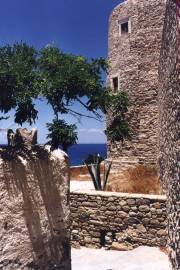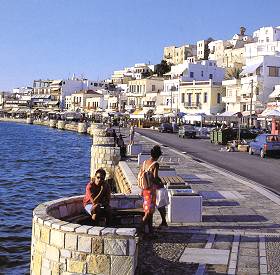Naxos History
 Naxos
is the largest island of Cyclades. According to the Greek mythology, the first
inhabitants came from Thraki and brought with them the worship of Dionysos. Naxos
is the largest island of Cyclades. According to the Greek mythology, the first
inhabitants came from Thraki and brought with them the worship of Dionysos.
On this island, Theseus
-returning from Crete where he killed Miinotaurus- abandoned Ariadni on the
seashore while she fall asleep. The numerous ancient monuments stand as a
witness of the island's development. During the Byzantine period, Naxos became
the permanent target of Aegean Pirates and as a result the inhabitants abandoned
the seashore territories and withdrawed on the mountainous hinterland in order
to protect their lives.
In 1207 a.c. the island was
conquered by the Turks until its liberation followed by its rejoice with Greece
in 1832.
Arriving at the harbor of
Naxos, the traveler can see the ruins of Apollo's ancient temple, which the
inhabitants call Portara (6th century b.c.). In Chora there is also the
Archaeological Museum of the island, with a big collection of Cycladic idols,
jewellery, statues etc.
In the village Melanes there
is an uncompleted, huge statue (Kouros). Another one is near the village of
Apollonas, where there are also ruins of an ancient stone-pit of Marble.
Near the village Sangri there
is another ancient temple devoted to Goddess Dimitra, as well as the ancient
Dilio (another temple of Apollo).
 At
the top of the mountain Zeus (Zas) there is a cave, where according to the Greek
mythology Zeus (the god Jupiter) was born. At
the top of the mountain Zeus (Zas) there is a cave, where according to the Greek
mythology Zeus (the god Jupiter) was born.
Chora is the capital of
Naxos, a picturesque town constructed around the Venetian Castle, standing as a
characteristic example of the traditional Cycladic architecture: narrow little
roads, series of arches and stone curred steps. Another castle of the island is
the ancient and medieval castle of Apano Meria, between the villages of Potamia
and Chalki.
Also there are several towers
in Naxos, built in the hinterland of the island by the Venetians, in purpose to
protect the people from the Pirates: Tower of Chimaros, Belonia, Barotsi,
Aperathou.
|